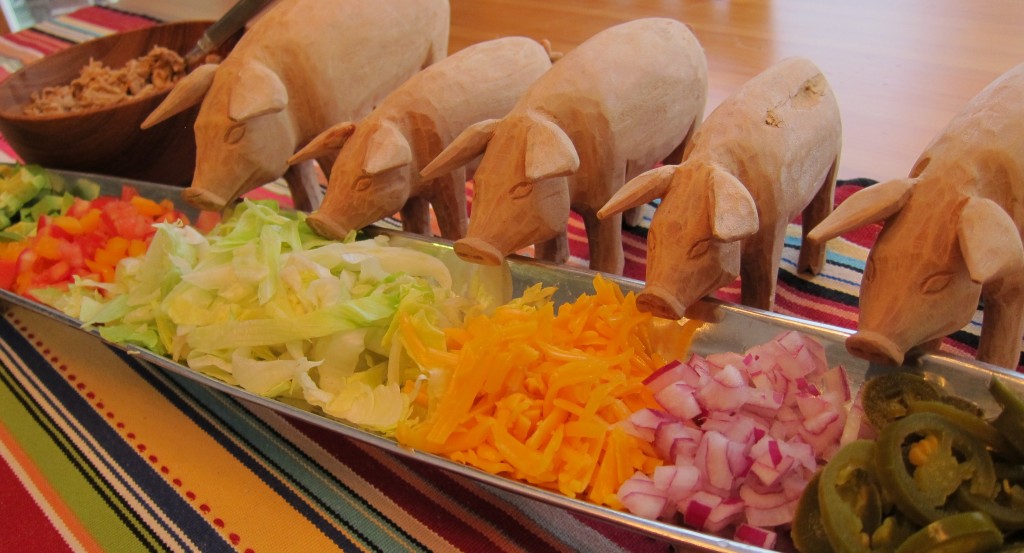We’ve been enjoying glorious spring weather here in Houston. Cultivated bluebonnets are appearing in neighboring yards:
Frilly azaleas are in full bloom (on the heels of the redbuds, lorapetalum, and Japanese magnolias). It’s almost as if the city were spray painted with big splotches of pink, purple, and white:
Those are what I call azaleas!
These huge azaleas tend to be found on older homes. Landscapers today tend to favor Encore azaleas, which grow in tidier formations not much more than about 16 inches tall, and promise to bloom year round. (The “bloom year round” thing, unfortunately, is kind of a joke. They manage to choke out a few blossoms in the warmer weather, but they are decidedly not spectacular.)
Encore azaleas
I came across a tree that was filled with birds that I didn’t instantly recognize. There must have been 30 of them, flitting about, eating the berries on the tree. I sat and watched them for a while, completely mesmerized. I later learned that they were Cedar Waxwings.
Cedar Waxwings
The farmers market was packed this weekend, with people coming from all over to enjoy the great weather. I came home with some beautiful produce, including tender broccoli side shoots (we love these):
Green onions in bud (I think these look like baby leeks, but am told they’re green onions):
And never-cease-to-delight-me candy-striped Chioggia beets:
 Don’t be fooled by their plain exterior
Don’t be fooled by their plain exterior
The beauty within
Most of the produce came from Atkinson Farms, one of my favorite vendors. As I completed my purchase and started to walk away, I noticed something on a back table, a sort of Land of Misfit Vegetables. Beep, beep, beep — I backed up to get a better look. Wait. Was that . . . . Could it be . . . ? Cardoons?
Mr. Atkinson confirmed that they were, in fact, cardoons. Up until then, I had only read about cardoons, and at this point, my nose was probably twitching with excitement. I asked him what do you do with them, and he answered with the same answer I get whenever I ask him about any vegetable he sells — “eat them.” I told him I figured that out, and he kind of smiled and very patiently explained to me how to prepare them. Turns out, they are a bit of work, which is why, he said, people don’t like to buy them. Silly people. He handed me a bunch, told me they were on him, and to let him know what I thought of them. Oh, Joy is my new middle name!
Cardoons, like artichokes, are thistle-like members of the sunflower family. Mr. Atkinson was right, they are a bit of work. You first have to strip the leaves, which are bitter, and trim the outside layer, which is stringy. I’m not sure how to describe the inside of the stalk — it looks like a series of tubes. As the stalks mature, they become hollow and more stringy.
Next, the prepared cardoons need to be simmered in salted water for about 30 minutes until they’re tender. Then they’re ready to be used in any number of ways — sliced and added to pasta, breaded and fried, gratineed, etc.
I topped my cardoons with a mixture of 1/2 cup Italian seasoned breadcrumbs and 1/4 cup grated parmesan cheese, then dotted it with about a tablespoon of butter and baked at 350 degrees for about 20 minutes, until the topping was browned.
 Looking at cardoons, you might expect them to taste like celery. You would be wrong, and really, why would you want to go to all that trouble for something that tastes like celery, when you could just eat celery? You may have heard that they taste like artichokes. More accurately, they taste EXACTLY like artichoke hearts. And for that, the hassle is worth it.
Looking at cardoons, you might expect them to taste like celery. You would be wrong, and really, why would you want to go to all that trouble for something that tastes like celery, when you could just eat celery? You may have heard that they taste like artichokes. More accurately, they taste EXACTLY like artichoke hearts. And for that, the hassle is worth it.
























I have never heard of cardoons, but if they taste like artichokes I’m in! If I ever stumble across them, I am definitely trying this recipe.
I would like to just spend the day at your house being your taste tester. Everything looks delicious & is inspiring!!